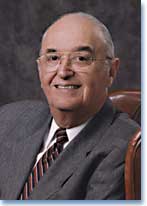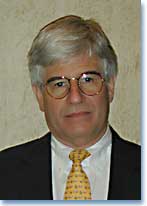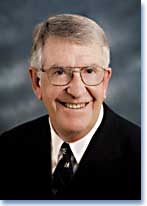RSNA Press Release
RSNA Honors Drs. Baum, Bradley and Fraser with Gold Medals
Released: December 2, 2003
|
Media Contacts: |
Heather Babiar or Maureen Morley | (630) 590-7762 |
| Heather Babiar (630) 590-7738 hbabiar@rsna.org |
Maureen Morley (630) 590-7754 mmorley@rsna.org |
CHICAGO, Dec. 2, 2003 — The Radiological Society of North America (RSNA) today bestowed its highest honor, the Gold Medal Award, on Stanley Baum, M.D., Philadelphia; William G. Bradley Jr., M.D., Ph.D., San Diego; and David B. Fraser, M.D., Nova Scotia, Canada.
Gold Medals have been presented annually since 1919 by unanimous vote of the RSNA Board of Directors to individuals who have demonstrated unusual and exceptional service to the science of radiology.
Stanley Baum, M.D.
A medical pioneer, the unwavering dedication of Dr. Baum to radiologic research and education was instrumental to the formation of a medical imaging institute at the National Institutes of Health.
"Stanley Baum will always be remembered for being first," said RSNA President Peggy J. Fritzsche, M.D. "He was one of the first interventional radiologists in the country, and was the founder and first president of the Society of Cardiovascular and Interventional Radiology. He established the first hospital-based magnetic resonance (MR) program in the country. He was also one of the first diagnostic radiologists elected to the Institute of Medicine."
"Being awarded a Gold Medal is a great honor and to receive it for work that I have always enjoyed doing is a double honor," Dr. Baum said. "RSNA is the world's greatest research and education organization, and I am absolutely delighted to receive this award."
For more than 20 years, Dr. Baum was professor and chairman of the Department of Radiology at the University of Pennsylvania (Penn) in Philadelphia. Under Dr. Baum's leadership, Penn purchased its first computed tomography (CT) unit for imaging the head and its first body CT unit. He also contributed to early magnetic resonance (MR) imaging development, made a significant impact on angiography by describing the role of vasoconstrictors in controlling gastrointestinal bleeding and the role of angiography in assessing vascular bleeding with contrast material.
In addition to these monumental achievements, some of Dr. Baum's most important work came after he stepped down as chairman at Penn. He was a founding member of the Academy of Radiology Research (ARR) and was ARR president when the bill to establish the National Institute of Biomedical Imaging and Bioengineering (NIBIB) was introduced in the Senate.
Currently, Dr. Baum is an ad hoc member of the National Cancer Institute Training Grant Study Section. He is also editor-in-chief of Academic Radiology. Dr. Baum has worked on numerous editorial boards and is author or coauthor of more than 160 peer-reviewed publications and book chapters. He was also editor of Abrams' Angiography.
An RSNA member since 1973, Dr. Baum served as chairman of the Interventional Radiology Refresher Course Committee and as a member of the Public Information Advisory Board. He holds many professional association memberships and has received numerous awards. In 2002, Penn established the Stanley Baum Professorship in the Department of Radiology.
William G. Bradley Jr., M.D., Ph.D.
One of the world's leading experts in both the basic science and clinical applications of MR imaging, Dr. Bradley has developed the science of MR imaging into a useful tool for radiologists and other clinicians for nearly 25 years.
"Bill Bradley is credited for developing MR imaging into a widely used diagnostic examination," said Dr. Fritzsche said. "He is famous for his national and international MR imaging lectures, as well as for his mini MR imaging fellowships. He inspires trainees to excel at all levels. Anyone who meets Bill is intrigued by his intellectual curiosity, enthusiasm and fun-loving spirit."
"The greatest honor one can have is recognition by one's peers," Dr. Bradley said. "RSNA's Gold Medal is the embodiment of that recognition. I am truly honored by this award, yet fully cognizant that whatever contributions I made to radiology were always part of a team effort—whether it was my family, my partners or my fellows. This honor really belongs to all of them."
Armed with a Ph.D. in chemical engineering, Dr. Bradley's early activities in MR imaging involved translating the physics so they could be understood by radiologists and other clinicians. Since the early 1980s, he has published extensively on cerebral MR imaging including flow phenomena, hemorrhage, normal pressure hydrocephalus, stroke, contrast agents and spectroscopy.
Throughout his career, Dr. Bradley has held an academic appointment at the University of California, San Diego. He also served as director of MR imaging at the Huntington Medical Research Institutes in Pasadena and at Long Beach Memorial Medical Center. He is currently professor and chairman of the Department of Radiology at the University of California.
An RSNA member since 1982, Dr. Bradley has been actively involved in the annual scientific assembly. Dr. Bradley currently serves as chairman of the RSNA Research & Education Foundation Fund Development Committee, is a member of the Foundation's Honors Council and is a member of the Public Information Advisors Network.
Dr. Bradley holds a U.S. patent for "High Resolution Magnetic Resonance Imaging of Body Cavities" licensed by MEDRAD for prostate coil. He is a diplomate of the American Board of Radiology (ABR) and holds a certificate of added qualification (CAQ) in neuroradiology.
He is author or coauthor of more than 420 peer-reviewed journal articles, abstracts, book chapters, invited papers and books, including the best-selling textbook, Magnetic Resonance Imaging. He has received numerous awards and holds many professional memberships.
David B. Fraser, M.D.
A guiding force in radiology for nearly 50 years as a mentor, teacher, researcher and leader, Dr. Fraser spent most of his career at Dalhousie University in Halifax, Nova Scotia, where he retired in 1999 as professor and chairman of the Department of Radiology. He was also head of the Department of Diagnostic Radiology at Victoria General Hospital and at Queen Elizabeth II Health Sciences Center.
"David Fraser has been a towering figure in Canadian radiology and not only by virtue of height," Dr. Fritzsche said. "He was well respected as the radiology chair at Dalhousie University and served as a mentor to those of us becoming chairs elsewhere after him. His approach to life is summed up by his performance on the tennis court—no ball shall pass, but will be returned with interest in either spin or speed."
"I consider receiving the RSNA Gold Medal as the greatest possible honor I could have and feel very humble knowing the outstanding list of colleagues who have received this honor before me," Dr. Fraser said. "It's been a great opportunity and privilege to work with RSNA, an organization focused on improving medical care through research and education."
Dr. Fraser is a leader in cardiovascular imaging with a passion for teaching and a gift for negotiation. During an era in which Canada faced cutbacks, healthcare reform and many other crises, Dr. Fraser guided his department through an unending sequence of renovations, equipment acquisitions and the often tenuous relationship between cardiology and radiology.
An RSNA member since 1974, Dr. Fraser has been an active volunteer. He served as chairman of the RSNA Technical Exhibits Committee and was a member of the RSNA Board of Directors from 1990 to 1997, becoming the Society's president in 1998. He also worked on the RSNA Research & Education Foundation Board of Trustees, serving as chairman in 2001. He is currently chairman of the RSNA Membership and Credentials Board.
Dr. Fraser is a past-president of the Canadian Association of Radiologists (CAR) and is currently a member of the CAR Organizing Committee for the ICR 2004 meeting in Montreal. He is a member of many other professional societies and has earned a variety of awards including the CAR Gold Medal and the Commemorative Medal for the Queen's Golden Jubilee. He is the author or coauthor of numerous papers and publications focusing primarily on cardiac imaging and radiologic education.
RSNA is an association of more than 35,000 radiologists, radiation oncologists
and related scientists committed to promoting excellence in radiology through
education and by fostering research, with the ultimate goal of improving patient
care. The Society is based in Oak Brook, Ill.
 |
 |
 |
Stanley Baum, M.D |
William G. Bradley Jr., |
David B. Fraser, M.D. |
# # #
 PDF
PDF